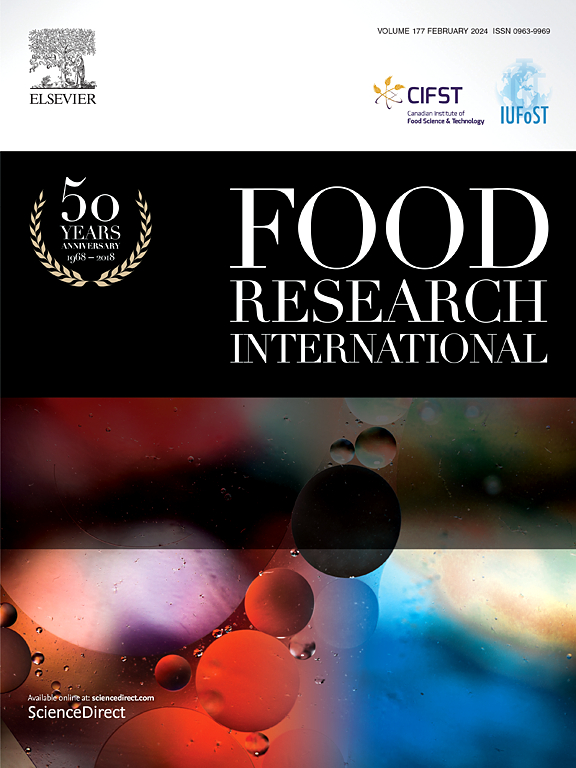Characterization of quorum quenching enzyme AiiA and its potential role in strawberry preservation
IF 7
1区 农林科学
Q1 FOOD SCIENCE & TECHNOLOGY
引用次数: 0
Abstract
Microbial spoilage in nutrient-rich strawberries has led to significant food waste and economic loss in the food industry. The quorum-quenching enzyme AiiA is believed to disrupt communication between cells by inactivating AHLs-based quorum sensing signals. Chitosan, a biopolymer derived from chitin, is widely used as a coating film to inhibit bacterial growth and prolong food shelf life. The present study aims to investigate the individual and combined effects of AiiA and chitosan on the preservation of strawberries. AiiA was synthesized in vitro and the reaction conditions for the degradation of AHLs signals were optimized at temperatures ranging from 20 to 60 °C and a pH of 8.0. The present study provides evidence that AiiA effectively inhibited the processes of biofilm development, production of exopolysaccharides, and extracellular protease activity in Enterobacter sp. and Pseudomonas aeruginosa (P. aeruginosa). Utilizing the bioprotective characteristics of AiiA, we implemented it in the preservation of strawberries. Our experiments show that AiiA, when used alone, improved the brightness, redness, and hardness of strawberries infected by Enterobacter sp. When combined with chitosan, AiiA had a notably beneficial effect on the sensory quality, color, hardness, and soluble solids content of strawberries that were infected with Enterobacter sp. and P. aeruginosa. Both AiiA alone and AiiA combined with chitosan treatment effectively reduced bacterial and fungal counts in strawberries infected by P. aeruginosa and inhibited bacterial growth in those strawberries infected by Enterobacter sp. Our study provides evidence that AiiA, either alone or in combination with chitosan shows potential application in preserving agricultural products.

群体猝灭酶AiiA的特性及其在草莓保鲜中的潜在作用
在营养丰富的草莓中,微生物的腐败导致了食品工业的大量食物浪费和经济损失。群体猝灭酶AiiA被认为通过灭活基于ahls的群体感应信号来破坏细胞间的通信。壳聚糖是一种从几丁质中提取的生物聚合物,它被广泛用作抑制细菌生长和延长食品保质期的涂膜。本研究旨在探讨AiiA和壳聚糖对草莓保鲜的单独和联合作用。体外合成了AiiA,优化了反应温度为20 ~ 60℃,pH为8.0的条件下降解AHLs信号的反应条件。本研究提供证据表明,AiiA有效抑制肠杆菌和铜绿假单胞菌(P. aeruginosa)的生物膜发育、胞外多糖产生和胞外蛋白酶活性。利用AiiA的生物保护特性,将其应用于草莓的保鲜。实验表明,单独使用AiiA可改善肠杆菌感染草莓的亮度、红度和硬度;与壳聚糖联用时,AiiA对肠杆菌和铜绿假单胞菌感染草莓的感官品质、颜色、硬度和可溶性固形物含量均有显著改善。AiiA单独处理和AiiA与壳聚糖联合处理均能有效降低铜绿假单胞菌感染草莓的细菌和真菌数量,抑制肠杆菌感染草莓的细菌生长。本研究表明,AiiA单独处理或与壳聚糖联合处理在农产品保鲜方面具有潜在的应用前景。
本文章由计算机程序翻译,如有差异,请以英文原文为准。
求助全文
约1分钟内获得全文
求助全文
来源期刊

Food Research International
工程技术-食品科技
CiteScore
12.50
自引率
7.40%
发文量
1183
审稿时长
79 days
期刊介绍:
Food Research International serves as a rapid dissemination platform for significant and impactful research in food science, technology, engineering, and nutrition. The journal focuses on publishing novel, high-quality, and high-impact review papers, original research papers, and letters to the editors across various disciplines in the science and technology of food. Additionally, it follows a policy of publishing special issues on topical and emergent subjects in food research or related areas. Selected, peer-reviewed papers from scientific meetings, workshops, and conferences on the science, technology, and engineering of foods are also featured in special issues.
 求助内容:
求助内容: 应助结果提醒方式:
应助结果提醒方式:


